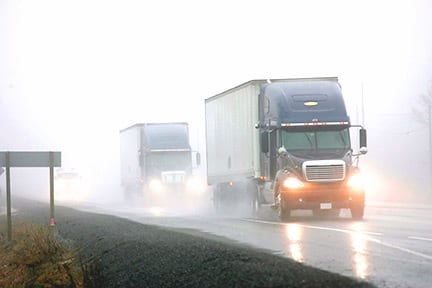Driving a semi-truck can often times be emotionally and physically taxing to even the best of drivers. One of the many things that can make driving difficult is the different weather elements drivers can encounter on a single drive shift. One of the weather conditions that can greatly affect driving conditions is rain. Rain not only can impede a driver’s progress but it often times can occur without warning and have a large area of impact. Thus, knowing how to practice and maintain safe driving behaviors in the rain is crucial to your overall safety.
The first rule of thumb is to always start your trip off right! A quick check of the weather before you begin your trip is always a good idea. Maybe, you could make use of a professional weather station for this purpose. Proper planning requires a driver to not only review where they must be, but when they must be there. You cannot accurately know how long a trip may take unless you do the research to know what type of weather forecast is to be expected during the course of your trip. When you are checking the weather, do not just look at the weather for the current city you are in. You can travel a great distance during your allowable 11-hour drive time, and sometimes you will drive through multiple weather systems. So, KNOW BEFORE YOU GO! To do this, find a few large cities on your map that you will be traveling through during your drive shift. Then, plot the expected forecast for each city. You can never be too prepared and knowing the weather will give you an idea of what you may be up against. The fewer the surprises, the better off and safer you will be.
Another rule of thumb is to use your headlights and windshield wipers while driving in the rain. Your headlights and your windshield wipers are your most useful tools in rainy conditions. During your pre-trip it is important to always make sure you are double-checking that your headlights and windshield wipers are in good working condition.
We all know that It is not a matter of if but when it comes to driving in the ran. So, when you encounter rain, you need to first SLOW DOWN and INCREASE YOUR FOLLOWING DISTANCE. Doing this will give both you and your brakes the proper reaction time needed to stop or slow safely. Also, if your company plans to be assessed for iso 18001 certification, it is important to ensure proper workers’ safety, and this means doing everything in your power to prevent you and your staff from getting hurt. As a result, you should make sure the brakes, headlights, engine, and all other parts of the vehicle are in good working order and that the drivers are not put in any potentially dangerous situations.
Another reason to slow down in the rain is because early on in a rainstorm, the rain mixes with the traces of oil and grease that has accumulated on the roadway. This mixture creates a dangerously slick residue on the roads creating a possibly hazardous situation. Rain also greatly restricts your field of view and distorts your vision. In addition, the over-spray from your tires reduces your ability to see cars in your blind spots. So, as your visibility decreases and your reaction time increases, your only defense to these adverse conditions is to slow down. As a general rule, if you cannot clearly see 7 – 10 seconds ahead of you, you are driving too fast.
Sometimes conditions worsen to the point that you may have to find a safe place to park your truck for a while and wait out the storm. If you have to stop during a rain storm, it is important to take certain precautions. For instance, before setting out for the journey, you can refer to the guidelines published by stormwater prevention plan companies in houston tx (or your local region) and take necessary measures accordingly. Rain often brings heavy winds, so, if possible, park the cab of your truck toward the wind to prevent a possible tip-over during extreme wind gusts called, “down-drafts.” Also, make sure you are careful about where you park your semi truck and trailer. Stay away from soft soil/grass, dirt/mud or loose gravel when water levels are high, you don’t want to get stuck!
Another safety risk created by rain is hydroplaning. Hydroplaning occurs when a thin layer of water separates the tires from the road. When your truck tires lose traction, your truck and trailer can drift out of control. Hydroplaning greatly reduces your ability to use your brakes. Even if you do not hydroplane, braking too hard can cause you to lose control of your truck. To prevent these risks, you should reduce your speed by 1/3 the posted speed limit, stay alert, maintain control of your truck at all times, increase your following distance, brake gradually and be patient with yourself and others. Additionally, you can also look into the Autel ADAS system or similar brands to get features such as adaptive cruise control, anti-lock braking systems, blind-spot monitors, night vision, backup cameras, forward-collision warnings, rain sensors, and many more. Advanced Driver Assistance System can reduce the chance of getting into an accident on a rainy day.
Rain can be tricky, and no storm is ever the same. Take rain seriously and be prepared to drive in it. Go slow and increase your following distance. Be patient with the situation and always be an example to the other motorists around you. Remember that they are fighting their way through the same storm you are. Everyone wants to get to their destination, be part of the reason you all get there safely.








